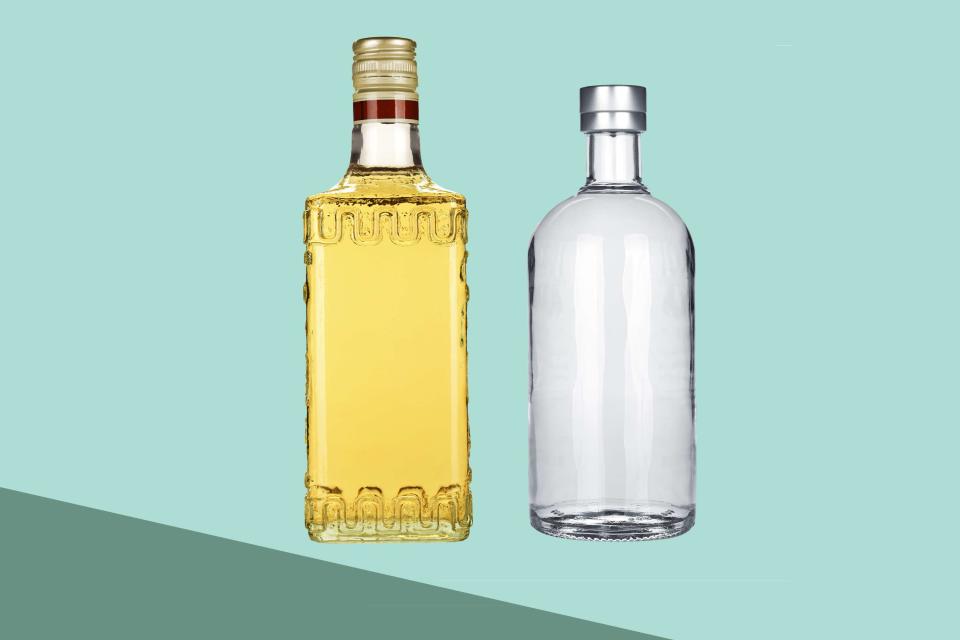Are You a Tequila Person or a Vodka Person?
The two spirits look alike, but that's really where the similarities end.

Getty
Fill a rocks glass with a few ounces of vodka and another with blanco tequila, and you’ll notice that it’s impossible to tell them apart just by looking. But as soon as you get within a foot of each, you’ll notice that aromatically, they couldn’t depart more from one another. That divergence follows through when they’re sipped, too.
For all of their production and sensory differences, vodka and tequila share a few important similarities, not least of which is their popularity in the American market.
According to the Distilled Spirits Council of the United States (DISCUS), vodka has become the backbone of the spirits industry, accounting for 27% of all volumes. In 2021, the last year for which they provided figures, that clear spirit was good for more than $7 billion for distillers in terms of total revenue. Tequila and mezcal (DISCUS combines stats for the two agave-based spirits) aren’t far behind: In 2022, they generated approximately $6 billion, a growth of $886 million from the year before, making it “the second-fastest growing spirits category by revenue and volume in 2022.”
Aside from their respective impacts on the marketplace, it’s important to take a deeper look at what sets them apart from one another, and the areas where they overlap.
Vodka and tequila are made from different raw materials
The range of materials that vodka can be produced from is broad. A quick scan of liquor store shelves reveals vodkas that have been distilled from potato, wheat, rye, corn, sugar beet, sorghum, quinoa, apple, honey, and more. As Food & Wine reported in 2020, the TTB, the federal agency that regulates alcohol in the US, changed its definition of the spirit to reflect the increasing granularity of the category. “‘Vodka is neutral spirits which may be treated with up to two grams per liter of sugar and up to one gram per liter of citric acid…Products to be labeled as vodka may not be aged or stored in wood barrels at any time except when stored in paraffin-lined wood barrels and labeled as bottled in bond.”
Tequila, on the other hand, is based on agave, which is surprisingly related to asparagus and plants in the lily family. Quality tequila will have a statement on the label that says “100% de agave”; be wary of bottles that don’t specify this, as the law for tequila without it only requires that 51% of the fermentable sugars in the initial mash come from agave…meaning that up to 49% can come from other sources. And make sure to pay attention to the NOM!
Vodka and tequila come from different places
Vodka knows no geographical bounds: It can be produced anywhere in the world. Often, it seems that it is. While vodka has historically been closely associated with Russia and Central and Eastern Europe, excellent examples of it can be found from New Zealand to Canada and everywhere in between. Indeed, thriving craft vodka industries have popped up and evolved around the planet, reflecting both local tastes and, occasionally, the base materials that grow there.
Tequila is the opposite: It can only be made in specific parts of Mexico, and utilizing a highly regulated method of production. According to the Academia Patrón, “[T]equila was the first internationally recognized Denomination of Origin for a region outside of Europe. The DO prescribes where tequila can be made [the entirety of Jalisco and parts of Michoacán, Nayarit, Tamaulipas, and Guanajuato], what it can be made from, where its raw material must be grown, and many other aspects of the production and marketing of tequila…”
Vodka and tequila call for different aging techniques
Vodka is, by definition, unaged (see the TTB’s definition above), whereas tequila has four distinct and highly regulated age categories. Blanco (usually unaged, though it can rest for up to two months before bottling), Reposado (aged in wood for anywhere between two and 12 months before bottling), Añejo (aged for a minimum of one year and a maximum of three years in wood); and Extra Añejo (aged for a minimum of three years in wood).
In general, tequila that has spent less time in oak will boast a more pronounced agave character, with the vegetal, herbal, and citrus notes more prominent. Longer-aged ones will be more influenced by the time they spend in their aging vessels. These well-aged tequilas begin to take on notes that whiskey lovers may find familiar: Vanilla, cinnamon, clove, caramel, and coffee, for example.
For more Food & Wine news, make sure to sign up for our newsletter!
Read the original article on Food & Wine.


